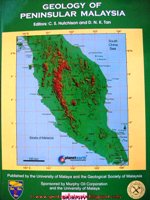C S Hutchison and D N K Tan (eds)
Published by: The University of Malaya and the Geological Society of Malaysia
Publication date: 2009
ISBN: 978-983-44296-6-9
List price: 200 Malaysian Ringgit +p&p (approx. £35.00)
479 pp + folded map
E:
[email protected]

It is now nearly 40 years since the Geology of the Malay Peninsula (Gobbett and Hutchison, 1973) was published. In the meantime, the country’s tin-mining industry has collapsed and an offshore oil and gas industry has been developed. At the same time an enormous amount of new geological information has been accumulated through the efforts of Malaysian and overseas geologists, and the whole conceptual basis of the geology of West Malaysia has been revolutionised through the application of plate tectonics.
This new volume will be welcomed by all geoscientists with an interest in the country and its region. It commences with a brief biography of each of the contributors, followed by an account of the geomorphology - mountainous interior dominated by linear granitic plutons with local areas of spectacular limestone tower karst, margined by narrow coastal plains and tidal flats, with mangrove swamps along the west coast. An overview of the regional tectonics is then followed by a short chapter detailing the geology of the Bentong-Raub Suture, a major structural feature bisecting the peninsula. This is interpreted as the zone of collision between two major plates, Sibumasu (Sino–Burma-Malaysia-Sumatra) and Indochina, which separated from Gondwana in the Palaeozoic and came together to form Southeast Asia in the Triassic.
Separate chapters are devoted to Palaeozoic, Mesozoic and Cenozoic stratigraphic units, detailing all the formations recognised in Peninsular Malaysia, with their definitions, lithology, palaeontology and evidence for their age. Noteworthy units include the intriguing Permo-Carboniferous Singha Formation, with its glacio-marine ‘pebbly mudstone’ deposits and diamonds, relating West Malaya to its origin in northwestern Australia as part of Gondwana. The eastern part of the peninsula includes Carboniferous, Permian and Triassic rocks with volcanics and plant beds containing Gigantopteris, linking the eastern part of the peninsula to Indochina and China.
In the Triassic the peninsula was the site of massive plutonic intrusions, but was largely exposed subaerially with marine and terrestrial sedimentation in a central graben structure. The Jurassic and Cretaceous are characterised by terrestrial red beds. Terrestrial Cenozoic deposits are restricted to small local basins on the eastern and western margins of the peninsula, some containing coal seams. Cenozoic deposits are more extensive in faulted graben offshore, to the west in the Malacca Strait and particularly to the east in the large hydrocarbon-bearing Malay and Penyu basins in the South China Sea. These basins are described in detail by Denis Tan, lately of Shell, with maps (and accompanying cross sections) showing the locations of oil and gas fields, and discussion of their origin and structural and sedimentary development. Their history of exploration and development are described in a separate chapter.
Further chapters cover other aspects of the geology: volcanism, plutonism, metamorphism, fault structures and deformation, tectonic evolution and mineral deposits. The volume is profusely illustrated with maps, diagrams, vertical sections and half-tone field photo’s and fossils. There are a few spelling errors in the text that should have been eliminated by more careful editing. The reference list shows that the greater part of geological research on the peninsula has been published in the Memoirs of the Geological Survey of Malaysia (now the Minerals and Geoscience Department Malaysia), local journals and volumes derived from regional seminars, so that it has not received wide circulation. This volume has a key role to play in improving access to this information. Together with accounts recently published or in preparation on the geology of North Borneo, Indonesia Borneo, Sumatra, Thailand and Vietnam, it will go a long way towards defining our present knowledge and understanding of the geology and geological history of mainland Southeast Asia, and will provide a sound basis for future research.
Reference:
- Gobbett, D.J. & Hutchison, C.S. (eds) 1973. Geology of the Malay Peninsula. Wiley-Interscience, New York, 438pp
Tony Barber
Department of Geological Sciences, Royal Holloway University of London